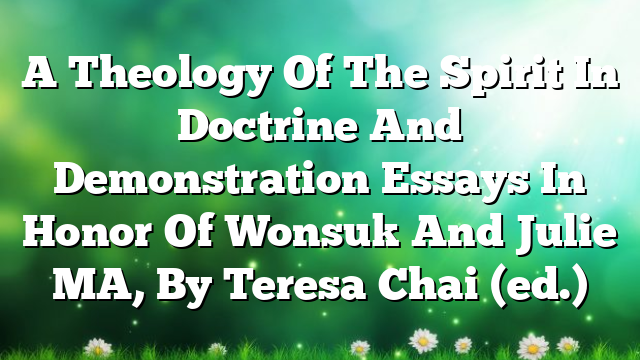Click to join the conversation with over 500,000 Pentecostal believers and scholars
Click to get our FREE MOBILE APP and stay connected
| PentecostalTheology.com



158
Book Reviews
Teresa Chai (ed.), A Theology of the Spirit in Doctrine and Demonstration: Essays in
Honor of Wonsuk and JulieMA(Eugene,OR: Wipf and Stock, 2014). 226 pp. $24.00
paperback.
Teresa Chai is the Academic Dean and the John Bueno Chair of Intercultural Studies at Asia Pacific Theological Seminary. She has earned a Bachelor of The- ology from the Bible College of Malaysia, a MA in Intercultural Studies from FullerTheological Seminary,and a PhD in Intercultural studies from FullerThe- ological Seminary. Chai has written several articles and has served as a member of the research committee forNECFand on a joint Consultative Group of Pen- tecostals and World Council of Churches for several years. Her teaching has taken her to various other countries: the United States of America, Bangladesh, China, Denmark, Hungary, India, Romania, Singapore, and South Africa. Chai is uniquely positioned to edit this festschrift in honor of Wonsuk and Julie Ma. The fact that the author is currently serving both as Academic Dean and regular faculty at Asia PacificTheological Seminary has given her a front row seat to see and experience the contributions Wonsuk and Julie Ma have made to the semi- nary. There are several scholars who contributed essays to this festschrift: Rose Engcoy, Amos Yong, Robert P. Menzies, Veli-Matti Kärkkäinen, Allan Heaton Anderson, Harold D. Hunter, Kirsteen Kim, J. Kwabena Asamoah-Gyadu, Eka- putra Tupamahu, R.G. Dela Cruz, and Dave Johnson.
Rose Engcoy opens up this collection of essays with a historical sketch of Wonsuk and Julie Ma. The Mas pursued a high level of academics that led them to PhD programs and participation in research, conferences, and pub- lication (5). They worked hard at contextualization (13) which was shaped by their involvement in local missions. Even after they attained their PhDs and were more focused in academia, they stayed connected to the local churches and leaders (11). Due to their involvement in the local churches, they encour- aged local leaders to seek out high level academics. They became champi- ons for providing access to local leaders by financially supporting some of their students and bringing awareness to the need of localized education (14– 15).
Amos Yong makes an argument for creating quality access to theological education and formation through using new and emerging technologies (27). He argues that this is part of a theology of Incarnation where God is meet- ing the creature in their contextual terms (28). Robert Menzies argues that Pentecostals have an important theological contribution to make to the larger church, because the Holy Spirit contributes to spiritual formation (41). Men- zies also links mission spirituality to the writings of Luke and the book of Acts, which he sees as a manifesto for the Christian mission: “Through this mani-
PNEUMA
© koninklijke brill nv, leiden, 2019 | doi:10.1163/15700747-04101023
1
Book Reviews
159
festo, Luke seeks to remind his readers of their true identity—i.e., they are a community of prophets called to be a ‘light to the nations’” (56).
Velli-Matti Kärkkäinen argues that a well-rounded theological education must include the study of world religions and interfaith relations. As global- ization is making the world smaller, world religions are co-mingling from the main street to the mission field, and our pastors and missionaries are having to learn about world religions on their own (59). Allan Heaton Anderson looks at the global landscape of Pentecostalism. He explains that as Pentecostalism has spread in countries that once were mission fields, there now there are fully trained and developed leaders in those countries that are adding their voices to the new global discussion speaking contextually about what the Holy Spirit has been up to in their contexts (70).
Harold Hunter argues that when it comes to traditional lines of apostolicity, Pentecostals poise a bit of a problem: Pentecostals have only two sacraments— baptism in water and the Eucharist (91), they have no primary model of min- istry (94), and they believe in the transformation not of elements and buildings but of believers (96). Pentecostalism is participatory, “every member should carry the flame” (97). Kirsteen Kim explores the contribution of Pentecostal- Charismatic perspectives to mission spirituality and mission pneumatology through reflection on the mission of the spirit (108). She focuses on three areas: 1) concerns the spirituality of the missionary (108), 2) the shift in mission moti- vation from obedience to the great commission to a response to God’s love (110), and 3) A way of relating to the mission dei and mission spirituality is to com- bine them to “mission in the spirit” (112). She explains, “Mission in the Spirit suggests that Christian mission begins with the spiritual activity of discerning the spirits in order to discover the ‘Lordship and resources’ of the Holy Spirit at work in the world” (126).
J. Kwabena Asamoah-Gyadu writes about the relationship between the Spirit and Ecumenism (130). He argues that Pentecostals-Charismatics are good at dialoguing between the various groups under their umbrella but strug- gle with the ecumenical dialogue with non-Pentecostal-Charismatic groups (128). He writes that “the desire to worship and work together is an important evidence of Pentecostal and Charismatic spirituality” (130). Ekaputra Tupa- mahu writes a very interesting essay where he looks at the Pentecostal expres- sion and experience through the “lens of the phenomenological analysis of religion” in the writings of William James and Rudolph Otto (155). Ekaputra makes an argument that often we try to define our religious experience in the- ological terms instead of understanding it in terms of human experience (164).
R.G. dela Cruz attempts to address three areas using textual criticism by analyzing codex D. The three areas are: 1) apostolic hierarchy-Peter’s role and
PNEUMA 41 (2019) 111–185
2
160
Book Reviews
place, 2) public status of early Christian women that were marginalized, and 3) divine authority of believers as manifested by the presence of the Holy Spirit (181–182). Dave Johnson’s essay is a brief explanation and example of contex- tualization in a local church. He uses the teaching of the Baptism of the Holy Spirit from a western perspective, showing how to reteach in a foreign context with different language and imagery. He states that two main components of contextualization are faithfulness to the biblical text and an accurate exegesis of the culture in which you are contextually teaching in. For Dave Johnson, this was the Philippines (206).
I would recommend this book to people who are interested in theological education, particularly those interested in making the gap between the Ivory Tower and the local church smaller. Readers might be surprised by how diverse this festschrift is; the topics of articles covered a wide range of subjects, though all the works did connect to Wonsuk and Julie Ma. Pastors, missionaries, stu- dents, and scholars can all glean something from the essays in this book.
Harvey Mitchell, Jr.
Talbot School of Theology, La Mirada, California harvey.v.mitchelljr@biola.edu
PNEUMA 41 (2019) 111–185
3


